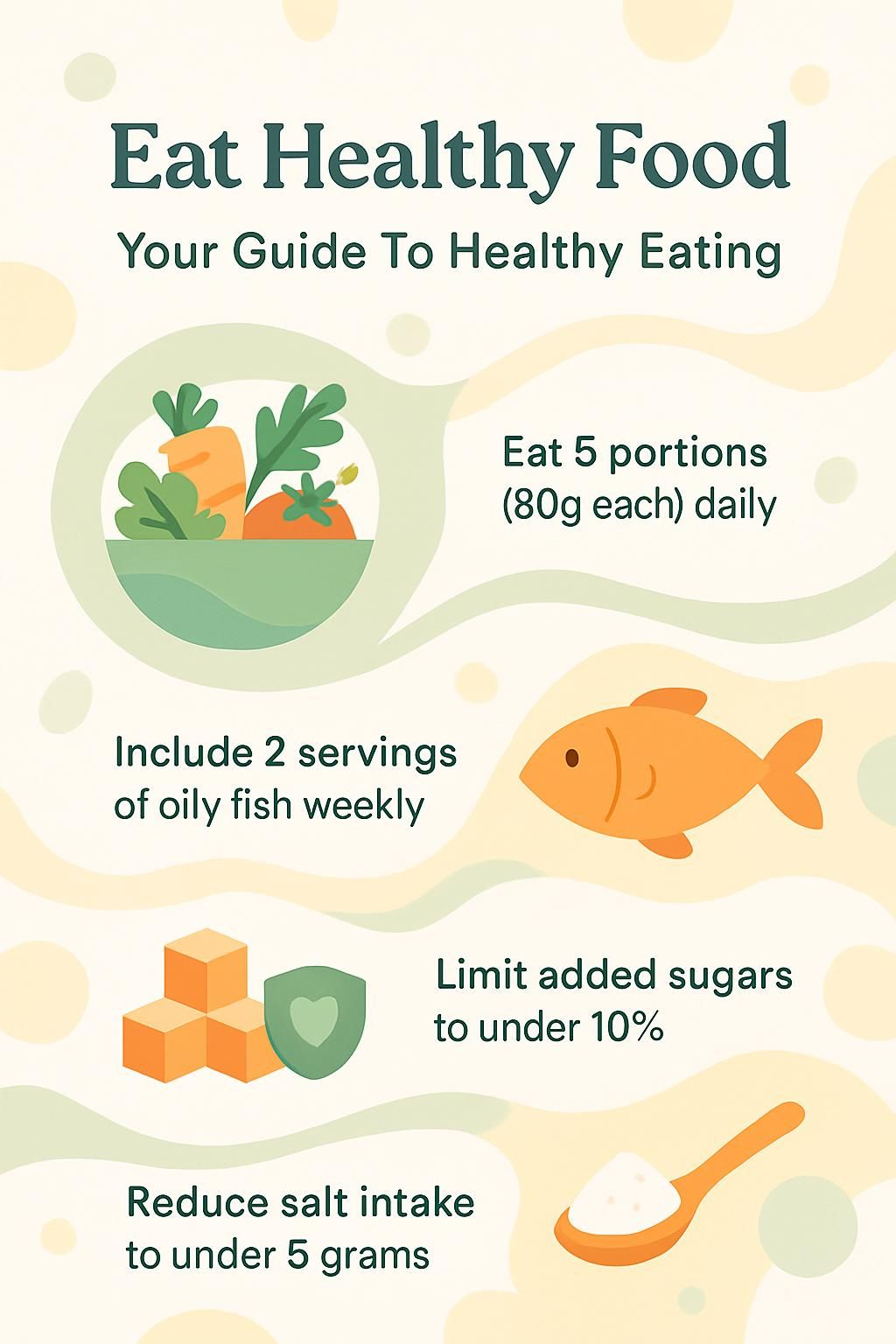Eat Healthy Food: Your Guide To Healthy Eating
Our Nutrition Assistant AI Suite will transform your body. You will lose fat, get toned, and build muscle. Gain confidence and optimal health.
Healthy eating can feel hard in a store full of choices. A healthy diet built on fruits, vegetables, whole grains, and lean protein protects your heart and helps manage weight. You do not need perfection. You need steady habits that fit your life.
This guide turns complex nutrition into clear steps. You will see what to choose, what to limit, and how to build balanced meals that taste good. Use these tips to make small changes that stick.
Key Takeaways
- Eat at least five portions of fruits and vegetables daily, about 80 grams per portion, to lower the risk of heart disease and other chronic conditions.
- Swap saturated fat, the kind that raises LDL cholesterol, for unsaturated oils like olive oil. Aim for two servings of oily fish each week for omega-3 fat.
- Limit added sugar to less than 10 percent of daily calories and keep sodium near 2,300 milligrams per day to support healthy blood pressure and blood sugar.
- Plan meals with tools like MyPlate to improve diet quality. Buying seasonal produce and cooking at home can cut grocery costs by 15 to 20 percent.
- Read labels to avoid trans fat. Artificial trans fat in partially hydrogenated oils was removed from the U.S. food supply after FDA action started in 2015.

What Is a Balanced Diet?

A balanced diet gives your body energy and the nutrients it needs to work well. You build it from all food groups in smart portions. That mix supports growth, repair, and steady focus during your day.
What Does a Balanced Diet Include?
A strong eating pattern pulls from each group. Think variety, color, and portions that match your needs.
- Fruits and vegetables: Aim for at least 5 portions daily, about 80 grams each. They deliver vitamins, minerals, fiber, and protective plant compounds called antioxidants.
- Whole grains: Make starchy carbohydrates at least one third of what you eat. Choose brown rice, oats, whole wheat bread, or whole grain pasta for more dietary fiber.
- Protein foods: Include fish, poultry, eggs, tofu, beans, and lentils. Try to eat fish twice per week with one serving of oily fish like salmon for omega-3 fat.
- Lean meats and legumes: Pick lean cuts of meat and include beans and peas for protein and iron with less saturated fat.
- Dairy or fortified alternatives: Low-fat milk, yogurt, or calcium-fortified soy drinks supply calcium and vitamin D for bones.
- Healthy fats: Use small amounts of oils like olive or canola. Add nuts and seeds for healthy fats that support heart health.
- Limit: Foods high in saturated fat, added sugar, and sodium. These raise the risk of heart disease and type 2 diabetes when eaten often.
Choosing nutrient-dense foods means you get more nutrition from every calorie. That is why these basics matter for long-term health.
Why Are Nutrient-Dense Foods Important?
Nutrient-dense foods give you many nutrients for relatively few calories. Dark green vegetables, berries, beans, and whole grains are top picks. One portion of fruits or vegetables is about 80 grams. A daily target of five portions supports heart and gut health.
According to the United States Department of Agriculture, whole grains like oats and quinoa are a great source of fiber, which supports digestion and helps with weight management. Oily fish such as salmon supplies omega-3 fat that supports your heart and brain.
Lean proteins, like chicken, beans, and nuts, repair muscles without too much saturated fat. Water hydrates without added sugar and helps you manage calories. Building your meals with these foods lowers the risk of obesity, heart disease, and type 2 diabetes.
What Are the Benefits of Eating Healthy?
A healthy eating pattern supports your body and mind. It fuels daily tasks, exercise, and clear thinking.
How Does Healthy Eating Improve Physical Health?
Eating a variety of fruits, vegetables, whole grains, lean protein, and healthy fats helps you manage weight and reduce chronic disease risk. Regular physical activity adds to these benefits.
Tools such as MyPlate make meal balance easier. Research on healthy eating patterns shows that people who follow them have lower rates of heart disease and some cancers over time. Choosing meals lower in saturated fat and sodium supports healthy blood pressure and cholesterol.
Portion control helps you avoid extra calories from fried foods and sugary drinks. Reducing sodium supports normal blood pressure and may lower stroke risk. Steady, nutrient-dense eating helps you stay active without feeling sluggish.
How Does Healthy Eating Enhance Mental Well-Being?
Many brain-friendly foods are also heart-friendly. Berries, nuts, whole grains, and colorful vegetables supply vitamins and minerals that support mood and focus. Keeping added sugar low helps smooth out energy and mood swings.
Drinking water through the day supports attention and reduces headaches for many people. A short walk or stretch paired with a balanced snack can settle nerves during busy days.
How Does a Healthy Diet Strengthen Your Immune System?
A healthy diet provides the building blocks your immune cells need. Fruits and vegetables provide vitamin C, folate, and potassium. Beans and nuts add zinc. Oily fish gives omega-3 fat that helps control inflammation.
Whole grains, beans, and nuts add fiber and protein for steady energy while your body repairs cells. Limiting added sugar and excess sodium may improve inflammation control. Many people notice fewer sick days after they shift to balanced meals with more produce and whole grains.
How Can Healthy Eating Reduce Chronic Disease Risks?
Healthy eating patterns protect your heart and blood vessels. Keep saturated fat under 10 percent of daily calories, and choose unsaturated oils instead. Aim for less than 2,300 milligrams of sodium each day, roughly one teaspoon of salt.
Reducing added sugar supports a healthy weight and helps prevent type 2 diabetes. Models like the Healthy Eating Plate and MyPlate make daily choices simpler. Try swaps such as fruit instead of candy or brown rice instead of white rice. Small steps add up to big changes over time.
Key Components of a Healthy Diet
Build your meals from nutrient-dense foods first, then adjust portions to your needs.
Why Are Fruits and Vegetables the Foundation of Nutrition?
Fruits and vegetables supply vitamins, minerals, fiber, and thousands of helpful plant nutrients. Aim for at least five portions per day, about 80 grams each for fresh, frozen, or canned produce. For dried fruit, a portion is about 30 grams. Limit juice to a small glass, about 150 milliliters.
Choose many colors like tomatoes, zucchini, berries, celery, cucumbers, and leafy greens. Each color signals a different mix of nutrients. These foods are naturally low in saturated fat and rich in antioxidants that help protect your heart.
How Do Whole Grains Provide Energy and Fiber?
Whole grains give you long-lasting energy from complex carbohydrates. Try to include a starchy food in each main meal. Whole wheat bread, brown rice, oats, and quinoa offer more fiber than refined grains.
Fiber helps you feel full and supports healthy digestion. It can also help lower LDL cholesterol. Many people find breakfast with whole grains gives them steady energy until lunch.
Why Are Lean Proteins Important for Muscles and Cells?
Lean protein provides amino acids, which are the building blocks for muscle and tissue repair. Good options include fish, poultry, eggs, tofu, beans, and nuts. Try to eat fish twice a week. Include one serving of oily fish like salmon or trout for omega-3 fat.
Limit processed meats such as bacon and deli meats. They often contain more saturated fat and sodium.
How Do Healthy Fats Support Brain and Heart Health?
Unsaturated fats help improve cholesterol levels and support brain function. Foods like olive oil, canola oil, avocados, nuts, and seeds are smart choices. Omega-3 fats from salmon, mackerel, and herring also support heart rhythm and may protect memory as you age.
Replace butter and other solid fats with liquid oils in cooking. This simple swap lowers saturated fat without losing flavor.
Why Include Dairy or Alternatives for Bones and Teeth?
Calcium and vitamin D support strong bones and teeth. Low-fat milk, yogurt, and cheese are common sources. Fortified plant drinks, such as soy milk, can provide similar calcium and vitamin D.
Most adults need about 1,000 milligrams of calcium daily. Aim for one to two servings of dairy or fortified alternatives per day, based on your needs and tolerances.
| Food or Drink | Approx. Calcium (mg) | Vitamin D Added |
|---|---|---|
| Low-fat milk, 8 oz | 300 | Yes |
| Fortified soy milk, 8 oz | ~300 | Yes |
| Hard cheese, 1 oz | 200-250 | No |
Choose calcium-rich snacks instead of sugary treats. That supports teeth and reduces extra sugar.
Which Foods Should You Limit or Avoid?
Learning what to limit helps you protect your long-term health. Simple swaps make a big difference.
Why Limit Processed and Packaged Foods?
Many packaged foods contain hidden saturated fat, added sugar, and sodium. Items like ready meals, some breakfast cereals, chips, and cookies often include more than you expect. Processed meats, such as bacon and hot dogs, are linked with higher risks of heart disease and certain cancers.
Swapping packaged snacks for fruit, vegetables, yogurt, or whole grain crackers can improve energy and digestion.
What Are the Risks of Sugary Drinks and Snacks?
Sugary drinks and snacks add calories without many nutrients. They can raise the risk of weight gain and tooth decay. Soft drinks and juice can drive blood sugar spikes, then energy crashes.
Check labels for total sugars. A product with over 22.5 grams per 100 grams is high, while 5 grams or less is low. Infuse water with fruit slices if you want flavor without added sugar.
Why Avoid Trans Fats and Hydrogenated Oils?
Trans fat increases LDL cholesterol and lowers HDL cholesterol. That combination raises the risk of heart disease. Many fried foods and commercial baked goods once contained artificial trans fat in partially hydrogenated oils.
The FDA moved to remove these oils from the U.S. food supply, and they are no longer allowed in most products. Still, check ingredient lists and avoid items that list hydrogenated or partially hydrogenated oils.
How Much Salt and Added Sugar Is Too Much?
For most adults, keep sodium under 2,300 milligrams per day, which is about a teaspoon of table salt. High sodium intake is linked to high blood pressure and stroke. Children need less.
Keep added sugar under 10 percent of your daily calories. Too much added sugar raises the risk of tooth decay, weight gain, and type 2 diabetes. Sweet drinks and desserts can push you past your limit fast. Reading labels helps you spot hidden sugar and sodium in packaged food.
Summary:
- Sodium: Under 2,300 mg per day for adults
- Added sugar: Less than 10 percent of daily calories
- Check labels on packaged foods for hidden sources
How Can You Eat Healthy Every Day?
Daily habits shape your health. Plan, prepare, and keep nutritious foods easy to reach.
Why Plan Meals and Snacks Ahead of Time?
Meal planning reduces last-minute fast food and helps you stick to budget and goals. Studies link planning with better diet quality and fewer impulse buys. MyPlate and the Healthy Eating Plate can guide portions and food groups.
Set a 15-minute planning session once per week. Map out simple breakfasts, packable lunches, and three easy dinners. Make a short snack list, such as yogurt, fruit, nuts, and cut vegetables.
How to Read Food Labels Effectively?
Labels help you compare products quickly. Focus on serving size, calories, and a few key nutrients.
- Check serving size first. Packages often contain more than one serving.
- Scan calories per serving to match your needs.
- Look at saturated fat and keep it low to protect heart health.
- Avoid trans fat and products listing hydrogenated oils.
- Review total and added sugars. Less is better in everyday foods.
- Check sodium. Aim for lower numbers to support blood pressure.
- Seek higher fiber for better digestion and fullness.
- Choose shorter ingredient lists with familiar items.
- Use percent Daily Value. Five percent DV or less is low, 20 percent DV or more is high.
- Be cautious with claims like low-fat or organic. Read the full label to decide.
With a little practice, labels make healthy choices faster at home, work, or school.
What Is Portion Control and How to Practice It?
Portion control means eating amounts that match your needs. It helps prevent overeating without strict calorie counting.
- Use the Healthy Eating Plate as a guide for vegetables, fruits, whole grains, and proteins.
- Fill half your plate with vegetables and fruits, a quarter with whole grains, and a quarter with lean protein.
- Match your plate to the serving sizes on the Nutrition Facts label.
- Try smaller plates to reduce overserving.
- Pre-portion snacks instead of eating from large bags.
- Avoid eating straight from packages.
- Eat slowly. Give your body time to feel satisfied.
- Watch liquid calories from soda, juice, and sweetened coffee.
- Use your hand as a guide: fist equals 1 cup, palm equals about 3 to 4 ounces of protein, thumb equals 1 tablespoon.
- Track portions in an app for a few weeks until it becomes routine.
Why Is Staying Hydrated with Water Important?
Water moves nutrients, removes waste, and helps control body temperature. Aim for 6 to 8 cups of fluid per day, more if you are active or it is hot outside.
Water is the best choice because it has no calories or added sugar. Lower-fat milk and unsweetened tea can also fit your plan. Keep a reusable bottle nearby to make hydration easy.
How to Build a Healthy Plate?
A well-balanced plate is like a daily blueprint. It shows you how to mix foods for both taste and nutrition.
How to Divide Your Plate for Balanced Meals?
Fill half your plate with vegetables. Choose leafy greens, carrots, peppers, or a mix of colors. Whole grains such as brown rice or quinoa should take up one quarter. The final quarter is for lean protein, like fish, beans, or skinless chicken.
Cook with olive or canola oil. Pair your meal with water, unsweetened tea, or coffee without added sugar. Many people find this visual method keeps portions in check during busy weeks.
Why Include Variety and Color in Your Meals?
Color signals different nutrients. Greens, oranges, reds, blues, and purples each add unique vitamins and plant compounds. Variety also keeps meals interesting so healthy eating feels more enjoyable.
Try a new fruit or vegetable each week. For example, add purple cabbage to wraps or roast orange sweet potatoes with dinner. Small changes expand your nutrient intake with little effort.
How to Eat Healthy on a Budget?
Healthy food can be affordable with a little planning and smart shopping.
Why Shop for Seasonal Produce?
Seasonal produce often costs less and tastes better. USDA data shows in-season items can be 15 to 20 percent cheaper. Local crops are picked closer to peak ripeness, which can mean more flavor and better texture.
Rotate your picks through the year. Spring berries, summer tomatoes, fall squash, and winter citrus keep your meals fresh and cost-conscious.
How to Buy in Bulk and Freeze Essentials?
Buy staples like brown rice, oats, and beans in bulk to save money. Store them in airtight containers. Purchase family-size packs of chicken or fish, then portion and freeze for future meals.
Cook big batches of soups, chilis, or grain bowls and freeze single servings. This cuts waste and gives you fast, healthy options on busy days.
How Does Cooking at Home Save Money?
Home cooking costs far less per serving than takeout. You also control ingredients, which helps limit saturated fat, added sugar, and sodium. Plan a simple weekly menu and reuse ingredients across meals to reduce waste.
Cooking once and eating twice is a budget-friendly habit. Turn roast chicken into a grain bowl the next day or use leftover beans for a quick soup.
What Is a Sample Healthy Meal Plan?
A basic plan can help you start strong. Adjust portions to your activity level, age, and health goals.
What Is a Healthy Breakfast Option?
Try oatmeal with berries and a few nuts. It delivers fiber, healthy fats, and protein. Whole grain cereal with milk and fruit also works well for steady morning energy.
Eating breakfast can support focus and reduce late morning snacking.
What Makes a Balanced Lunch?
Build lunch with half a plate of vegetables, a quarter whole grains, and a quarter lean protein. For example, a large salad with grilled chicken, tomatoes, cucumbers, avocado, and a slice of whole grain bread.
Meals rich in produce, lean protein, and whole grains can help keep blood sugar steady through the afternoon.
What Should a Healthy Dinner Include?
Match dinner to the same plate balance. Bake salmon with steamed broccoli and carrots, and add brown rice or quinoa. Use herbs, spices, and lemon for flavor instead of creamy sauces.
Try to include at least three colors of vegetables to widen your nutrient mix.
What Are Good Healthy Snack Choices?
Pick snacks that add nutrients. Examples include Greek yogurt with fruit, carrots with hummus, an apple with almonds, or whole grain crackers with peanut butter. These options combine fiber, protein, and healthy fats for lasting energy.
Keep added sugar low. Preparing snacks at home saves money and gives you more control over ingredients.
What Are Common Myths About Healthy Eating?
Confusing nutrition myths can slow progress. Clear facts help you spend your effort where it counts.
Is Healthy Eating Really Expensive?
It does not have to be. Beans, whole grains, seasonal produce, and frozen vegetables are affordable and nutritious. Cooking at home and planning simple meals can lower your weekly costs.
Do You Have to Give Up Favorite Foods?
No. You can fit favorite foods into a balanced diet with moderate portions. Many people follow an 80/20 approach, where most choices are nutrient-dense and a few are just for enjoyment.
Are Carbs Bad for You?
Carbohydrates are not bad. Choose healthy sources like vegetables, fruits, whole grains, and beans. These foods provide fiber, vitamins, and steady energy. Refined grains and sugary foods are the ones to limit.
How to Make Healthy Eating a Lifestyle?
Lasting habits grow from small, repeatable steps. Aim for consistency, not perfection.
How to Set Realistic Healthy Eating Goals?
Start with one or two specific goals. For example, add a vegetable to lunch each day or switch one sugary drink to water. Simple targets are easier to track and keep.
Use free tools like the MyPlate app or a short food journal to notice patterns and celebrate progress.
How to Gradually Introduce Healthier Choices?
Make one easy swap at a time. Replace white rice with brown rice at dinner this week. Add spinach to eggs tomorrow. Keep repeating small steps until they feel natural.
Why Celebrate Progress Instead of Perfection?
Small wins build confidence. Missing a goal one day does not erase your progress. Look for what went well, then adjust your next meal or snack.
Healthy eating is a long game. Consistency matters more than one perfect day.
Conclusion
Every meal is a new chance to practice healthy eating. Choose plenty of fruits and vegetables, whole grains, lean protein, and healthy fats. Keep added sugar, saturated fat, and sodium in check. Use MyPlate or the Healthy Eating Plate to guide your portions.
These steps support a healthy diet that fits real life. If you have medical conditions or special nutrition needs, talk with a registered dietitian or your healthcare provider for personal advice. With steady habits and simple planning, you can turn healthy choices into daily life, one plate at a time.
FAQs
1. What are the main benefits of eating healthy food?
Eating healthy food supports strong bones, a stable weight, and better heart health. Studies show that diets rich in fruits, vegetables, whole grains, and lean proteins lower the risk of chronic diseases such as diabetes and high blood pressure (Harvard T.H. Chan School of Public Health).
2. How can I start making healthier meal choices each day?
Begin by adding more fresh produce to your meals and choosing whole grain products instead of refined ones. Replace sugary drinks with water or unsweetened tea for fewer empty calories.
3. Which nutrients should I focus on for balanced nutrition?
Focus on getting enough fiber from beans and oats; protein from poultry or fish; calcium from dairy foods like yogurt; vitamins A and C from leafy greens and berries; iron from lentils or eggs.
4. Can you share a personal tip for sticking to healthy eating habits?
I found that planning weekly menus helped me avoid last-minute fast-food runs. Keeping cut fruit ready in my fridge made it easy to snack smartly during busy days.
Summary: Healthy eating means choosing nutrient-rich foods daily while limiting processed items high in sugar or salt. Simple changes like meal planning make it easier to maintain these habits over time according to research published by the Centers for Disease Control and Prevention (CDC).







